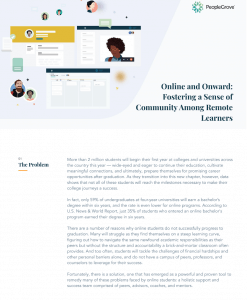Shareables
Fostering Community for Remote Learners
Remote learners lag their peers in reaching critical milestones.
Shareables
Remote learners lag their peers in reaching critical milestones.

More than 2 million students will begin their first year at colleges and universities across the country this year — wide-eyed and eager to continue their education, cultivate meaningful connections, and ultimately prepare themselves for promising career opportunities after graduation. As they transition into this new chapter, however, data shows that not all of these students will reach the milestones necessary to make their college journeys successful.
There are several reasons why online students do not successfully progress to graduation. Many will struggle as they find themselves on a steep learning curve, figuring out how to navigate the same newfound academic responsibilities as their peers but without the structure and accountability, a brick-and-mortar classroom often provides. And too often, students will tackle the challenges of financial hardships and other personal barriers alone and do not have a campus of peers, professors, and counselors to leverage for their success.
To broaden opportunities for community and connection among online students, colleges and universities must rethink their existing programs and create
more impactful ways to serve their digital communities. Let’s explore three key strategies which have already demonstrated promise and have been proven to
improve success rates for online learners. Details can be found in the shareable.

With more students demanding a meaningful return on investment, the time has never been better for universities to invest in academic and social programs designed to motivate, support, and encourage both short and long-term success for online students throughout the college lifecycle.